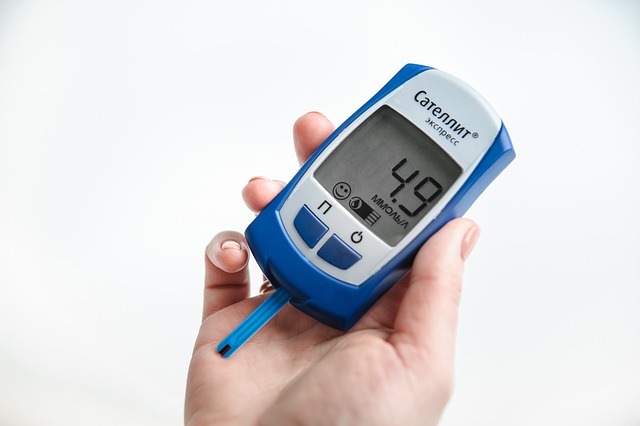Prediabetes is a condition with increased blood sugar, but how is it measured? Exactly what sugar level range is considered prediabetic, and how is that different from diabetes? Here is what you need to know about blood sugar levels in prediabetes, and what you can do about yours.
If you have been told that you have prediabetes, or you think that you might have it or be at risk for it, you can take your awareness in a positive way. While nobody actually wants to think about having a chronic health condition, being aware of prediabetes can be seen as a fork in the road of life.
On one branch of the fork in the road, prediabetes can lead to type 2 diabetes. Most people who get prediabetes take this branch, and end up with diabetes. However, you can choose to take the other branch in the road because in most cases, prediabetes is reversible.
Are you at risk for type 2 diabetes? Lark Diabetes Prevention Program is a personalized program to help you lower your risk by making healthy lifestyle changes, such as losing weight and increasing physical activity. Your personal Lark coach is available to support you 24/7 on your smartphone. Lark can help you make small changes that fit into your lifestyle and have big results for your health!
What Is Blood Sugar?
Blood sugar is sugar that is in your bloodstream. The specific type of sugar in your blood is called "glucose," and "blood sugar" is the same as "blood glucose." You need sugar in your blood because many of the cells in your body use it for fuel, or energy. It is normal and healthy to have some blood sugar, but too much is considered prediabetic.
So how does sugar get into your bloodstream? One way is after you eat a meal with carbohydrates. Another way is from your liver: if your blood sugar dips too low because you have not eaten for a while or for another reason, such as exercising, your liver will sense the lower levels and release stored sugar into your bloodstream. The goal is to keep your levels neither too high, nor too low, at all times.
Insulin, Blood Sugar, and Prediabetes
Prediabetes can develop when the system goes awry and your blood sugar levels increase. This happens due to resistance to a hormone called insulin, which is produced by an organ called the pancreas. Your pancreas release insulin when your blood sugar levels rise after a meal. Insulin helps sugar get out of your blood and into your fat, muscle, and some other cells so that they can use the sugar for fuel, and so that the extra sugar leaves your bloodstream.
Prediabetes happens when your cells become less sensitive, or more resistant, to the effects of insulin. You progressively need more insulin to get the sugar out of your blood and into your cells. Eventually, possibly after years or decades, your body cannot produce enough insulin to keep up with demand.
This is when blood sugar rises to the levels that are seen in prediabetes. At this point, your doctor might diagnose you with prediabetes after taking a blood glucose test. Even higher levels, which can happen if you do not treat prediabetes, indicate diabetes.
Blood Sugar Levels in Prediabetes
Blood sugar levels in prediabetes are higher than normal, but not as high as in diabetes. A fasting blood glucose or fasting plasma glucose test (FPG) or an oral glucose tolerance test (OGTT) can assess your blood sugar and can be used to diagnosis prediabetes.
You take the FPG after an overnight fast, without eating or drinking anything with calories. Then you get your blood drawn and wait for your results to come in, which could take hours to weeks depending on your lab and healthcare provider.
You also need to be fasting for an OGTT, and you will need to set aside extra time. You should also check with your lab to see if you need an appointment. In an OGTT, you drink a solution with 75 grams of sugar – for context, that is the amount in 2 cans of soda. Your blood will be drawn two hours later to assess prediabetes.
Blood Sugar and A1C Levels In Prediabetes
When talking about blood glucose levels in prediabetes and diabetes, you might also hear about A1C. The glycated hemoglobin test, or A1C, is another test that your doctor could order to determine if you have prediabetes or diabetes.
The FBG and OGTT measure blood sugar at the single moment in time when your blood sample is taken. In contrast, A1C helps evaluate your average blood sugar control over the past three months.
The A1C is slightly less common and more expensive than FPG, but not by much. You do not need to fast for the A1C, and it takes only a single blood draw, like the FPG. Here are the A1C values for normal, prediabetes, and diabetes:
Why Might Blood Sugar Rise and Cause Prediabetes?
Many factors can contribute to insulin resistance and an eventual increase in blood sugar levels and prediabetes. Some factors are genetic and you cannot change them. They include:
- Being over age 45 years.
- Being of certain ethnic backgrounds, such as African American, Latino, Native American, or certain Asian American groups.
- Having a family history of type 2 diabetes.
- Having heart disease or a history of stroke.
Other factors are related to lifestyle, and you can modify them. They include:
- Being overweight or obese.
- Not getting enough exercise or physical activity.
- Not getting enough sleep.
How to Lower Blood Sugar In Prediabetes
Now what? What should you do if you have prediabetes or risk factors for it? After getting tested, you have the choice. You can choose to take action and delay or prevent type 2 diabetes, or you can choose not to take action, and almost certainly get type 2 diabetes within years.
The great news is that "taking action" is not so hard! Most people with prediabetes can lower their blood sugar levels without taking medications. You can lower your risk for diabetes by over 50% with modest weight loss and regular moderate-intensity physical activity, such as brisk walking most days of the week.
Do you need help losing weight and getting active? Would you like motivation, tips for healthy eating and healthy behavior change, and personal coaching? Lark digital Diabetes Prevention Program offers 24/7 customized coaching via your smartphone, and it may be available to you for free through your health insurance plan.












.webp)








